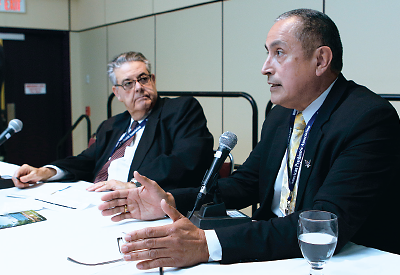Child Refugees May Have Harrowing Journey North
Abstract
Trauma experienced in their home countries or during their journey north from Central America may leave unaccompanied children in need of mental health care.
Unaccompanied children apprehended at the U.S.-Mexico border nearly tripled between 2012 and 2014—from 24,000 to 69,000—and brought with them a complex mixture of responses.
While the numbers appear to be lower so far this year, these children still represent a highly traumatized population, said Andres Pumeriega, M.D., a professor and chair of psychiatry at Cooper Medical School of Rowan University in Camden, N.J., at APA’s 2015 annual meeting in Toronto in May. “They are fleeing little-known conflicts at home and face an uncertain legal quagmire and an often hostile, anti-immigrant political climate in the U.S.”
Many of the child refugees travel north to the United States from Honduras, El Salvador, and Guatemala to be reunited with parents who arrived in the United States before them.
Even before the journey begins, many of these children face traumatic experiences. In their home countries, they may have experienced crime and violence or been threatened by or forced into gangs or paramilitary units. As they move north, the children, many of whom are alone, may experience more violence and danger as they traverse Mexico.
If picked up by U.S. Immigration and Customs Enforcement (ICE) agents, these children are held for a hearing within 21 days.

Families fleeing violence, repression, and poverty in Central America often travel to the United States in piecemeal fashion. As a result, children following their parents north may experience traumatic journeys, says William Arroyo, M.D. At left is Pedro Ruiz, M.D.
“They have no right to counsel, and it would take a lawyer [hired by the family] four to six weeks to properly prepare their case,” said William Arroyo, M.D., a regional medical director of the Los Angeles County Department of Mental Health and clinical assistant professor of psychiatry at the Keck USC School of Medicine.
“About 85 to 90 percent of these minors are then placed in communities, but ICE won’t give any information on where the children are released,” said Arroyo. ICE provides a minimal level of mental health services while these children are held, but such services are not guaranteed to be available after they leave ICE custody. “We do know that the amount of services they receive diminishes because of their undocumented status.”
No federal funds can be used to help these children, but some states such as California provide their own funds, he said.
This is not the first wave of unaccompanied children to reach U.S. soil, noted discussant Pedro Ruiz, M.D., a former APA president and a professor of psychiatry and behavioral sciences at the University of Miami Miller School of Medicine. At the start of the Castro era, more than 14,000 Cuban youth were sent to Florida by their parents (usually Roman Catholics fearing religious repression) in Operation Pedro Pan. They were resettled temporarily around the country by charities, but often haphazardly.
“Many of these children suffered from anxiety and nightmares when exposed to a culture not their own,” said Ruiz. “Many were so angry about their separation that they refused to talk with their parents when they were eventually reunited.”
Refugees aren’t the only ones to have to adjust to the realities of immigration, pointed out Kenneth Thompson, M.D., a clinical associate professor of psychiatry at the Western Psychiatric Institute in Pittsburgh. The people living in the country receiving immigrants may also experience challenges, as the community around them changes.
Such changes may lead some people in the host nation to feel their identity, familiar surroundings, security, or status is threatened, he said.
The response in the host country does not have to be negative, though. He noted that Toronto expected to add one million people to its population between 2005 and 2020, mostly immigrants.
“We must recognize the losses but focus on and foster the gains,” he said. “The host country can be accepting if it is ideologically ready and has the needed resources. We must address the concerns of the people who are anti-immigrant.”
That balance has to be achieved in helping the influx of child migrants, said Pumariega, who came to the United States from Cuba as a child.
“Children can be more adaptable to cultural change but also more vulnerable, especially when rejected,” he said. “The United States can work to integrate the new immigrants. The resiliency of these communities is amazing. People can see these changes through if they have the willingness, the patience, and the perseverance.” ■



